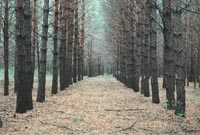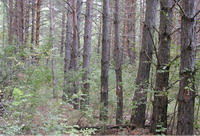Abstract
The author
considers
the idea of “wood coarse debris” of forest
communities. It’s been defined the
this composition has morphological (vertical and horizontal),
ecological and
functional structure. Morphological structure in the vertical
projection is
formed of morthorizons of current dead standing trees, wood coarse
debris
(wind-fallen trees) and root layer. Morphological structure in the
horizontal
projection is formed of micromortcinoses of current dead standing
trees, wood
coarse debris and rood layer. Ecological structure of dead standing
trees is formed of
mortsinusies. Morthorizons of
vertical and horizontal compositions of wood coarse debris’
morphological
structure are formed of a set of mortsinusies of its ecological
structure.
Functional structure of wood coarse debris is formed by its extended
links with
phytocenosis and ecotop. Presented cases, supported by experimental
data, prove
that wood coarse debris can be singled out as a cenotic level structure
among
other cenotic structures of forest biogeocenosis. The author suggests
that the
existing Sukachuov’s scheme of forest biocenosis structure
should be supplemented
by another structural composition which can be defined as
Key words: wood coarse
debris,
structures of forest communities, morthorizons, mortsinusies,
mortcenosis
References
Lippmaa,
Т.
La methode des
associations et le sisteme ecologigue des associations // Asta Inst.et
Horti
Bot. Univ. Tartuensis. 1935V.4. Fasc.
½.
Алёхин, В.В. Теоретические проблемы
фитоценологии и
степеведения. М.: МГУ, 1986.
213 с.
Беклемишев,
В.Н. О
классификации биоценотических симфизиологических связей // Бюлл. МОИП.
Отд.биол. 1951. Т.56. В.5. С.3-30.
Быков, В.А.
Введение в фитоценологию. Алма-Ата.: Наука. 1970. 231 с.
Бялловича,
Ю.П. Биогеоценотические
горизонты // Бюлл. МОИП.
Отд. Биол. 1960 Вып.3. С.43-60.
Дылис, Н.В.
Структура лесного биогеоценоза. М.: Наука. 1969. 55 с.
Ипатов, В.С.
Некоторые вопросы теории организации растительного покрова. // Ботан.
журнал.
1970. Т. 55. № 2. С.184-195.
Корчагина,
А.А.
Строение растительных сообществ. М.-Л.: Наука. 1976. Т.5. 283 с.
Лавренко,
Е.М.
Основные закономерности растительных сообществ и пути их изучения.
М.-Л. Из-во
АН СССР. 1959. Т.1. 70 с.
Мазинга,
В.В.
Консорции как элемент функциональной структуры биогеоценоза // Бюлл.
МОИП. Отд.
биол.1966. Т.27. В.2. С. 117-127.
Работнов,
Т.А. О структурных
элементах фитоценозов и
фитоценотических популяциях // Бюлл. МОИП. Отд.биол. 1965. Т. 90. В.1.
С.103-107.
Раменский,
Л.Г. О
некоторых принципиальных положениях современной геоботаники // Ботан.
журнал. 1952.
Т.37. № 2. С.181-201.
Сукачев, В.Н. Основы лесной
биогеоценологии. М.: Наука,
1964. 574 с.
Сукачева,
В.Н.
Избранные труды. Л.: Наука. 1972. Т.1. 343 с.
Стороженко,
В.Г.,
Бондарцева М.А., Соловьев В.А., Крутов В.И. Научные основы устойчивости
лесов к
дереворазрушающим грибам. М.: Наука.
1992. 221 с.
Стороженко
В.Г. Устойчивые
лесные сообщества. М.:
Из-во «Гриф и К». 2007. 190 с.
Уткин, А.И.,
Бязров
В.Г., Дылис Н.В., Солнцева О.Н.
Вертикально-фракционное распределение
фитомассы и принципы выделения
биогеогоризонтов в
лесных биогеоценозах
// Бюлл. МОИП. Отд. биол. 1969. Т.74. В.1. С.85-100.
Шенников,
А.П. Введение в геоботанику. Л.: Из-во ЛГУ.
1964 447 с.
Ярошенко П.Д.
Геоботаника:
Основные понятия, направления и методы. М.-Л.:
Из-во АН СССР.
1961.
474 с.





